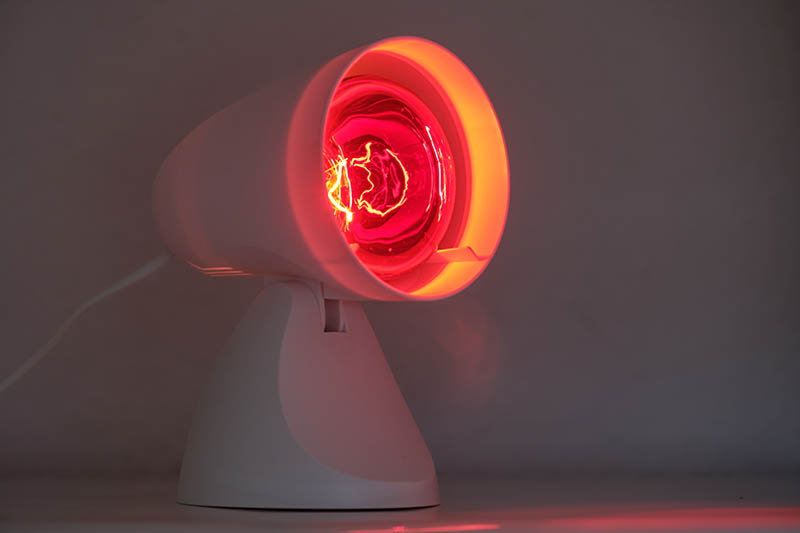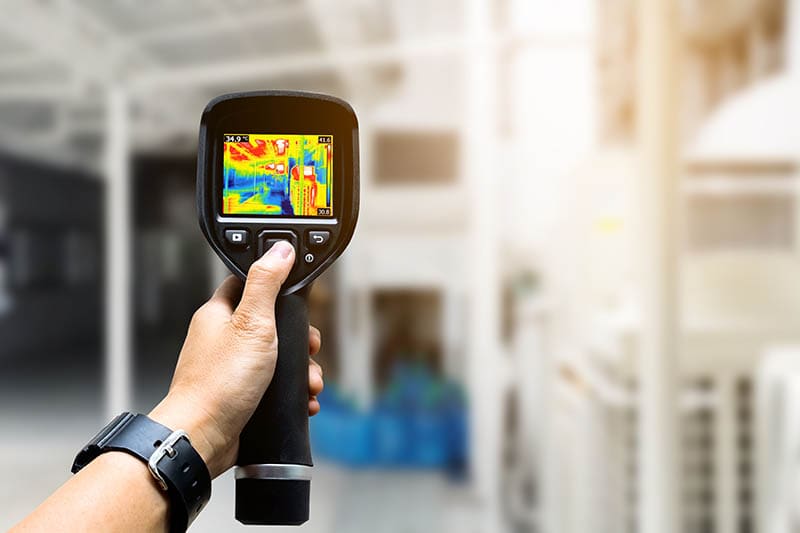Can Humans See Infrared Light? What to Know!
Last Updated on

Infrared light is radiant energy typically invisible to the human eye. It’s a type of electromagnetic radiation with a wavelength that is longer than visible light but shorter than microwave radiation.
While it is a common belief that humans cannot see infrared light, some research has shown that we may be able to see infrared light under specific conditions.1 However, the consensus is that we cannot see infrared radiation without the aid of technology.
Let’s discuss this in more detail.

What Does Research Say About Humans Seeing Infrared Light?
While most science textbooks will tell you that humans can’t see infrared light, some research suggests that we may be able to see it under specific circumstances.
Washington University researchers shot quick laser light pulses into the study subjects’ eyes. As a result, there was a “double hit,” which allowed these individuals to see green light flashes. It was infrared light.
Typically, we cannot see infrared light because the rays have less energy than the colors in the visible spectrum. Thus, infrared light rays do not activate our eyes’ photoreceptors.
The photoreceptors are the cells in our eyes responsible for vision. There are two types of photoreceptors: rods and cones. Cones are responsible for daytime vision and for seeing colors, while rods help in night vision.
Since infrared light has less energy than visible light, it cannot stimulate our cone cells. However, the Washington University study found that by using a laser to create a ‘double hit,’ hitting the same receptor with two photons one after another, they could stimulate the cone cells with infrared light.
While this research is promising, it should be noted that the study only looked at a very small sample size, so further research is needed to confirm these findings.

Which Other Light Can Humans Not See?
Besides infrared light, humans cannot see ultraviolet light, X-rays, or gamma rays. These types of light are outside of the visible spectrum. For instance, infrared light is too red for humans to see, and ultraviolet light is too blue. X-rays and gamma rays are even higher in energy than ultraviolet light.
Scientists use devices such as X-ray telescopes and gamma-ray detectors to detect and measure these types of light.
Can Cell Phones See Infrared Light?
While humans might not be able to see infrared light, some animals can. In fact, many animals use infrared vision to see in the dark.
The same is true for the cell phone in your pocket too. A cell phone transcends the biological limits of the human eye. Thus, it can somewhat “see” infrared light.
In fact, you can do a cool experiment at home with your cell phone and infrared remote control. If you put your cell phone’s camera up to the infrared receiver on your TV remote, you will see a faint light coming from the remote.
- Hold your TV remote. A TV remote uses infrared light to communicate with your TV. So, there should be an infrared receiver on the remote.
- Now, put your cell phone’s camera in front of this receiver. The receiver is on the end of the remote that you point towards the TV when pressing a button.
- Once you have your phone’s camera in front of the receiver, press a button on the remote. You will see a faint light.
- The light changes when you press different buttons since each button sends a different signal via infrared light.
Although this isn’t revolutionary, it’s a simple trick to show how your cell phone can see infrared light.

What Would We See If Infrared Light Was Visible to Us?
Infrared light exhibits less color and more temperature. Simply put, the hottest objects appear the brightest to our eyes. But what would we see if we could see infrared light?
The world would look very different. For starters, our bodies would be quite a sight. The human body constantly emits infrared light, and we would see each other as bright objects against the dark background.
Animals that are active at night would be much easier to spot. Their heat signatures would give them away, even if they tried to hide. Plants would also be quite different. In infrared light, they would appear as bright as the animals that eat them.
How Do Humans Use Infrared Light?
Even though we don’t see it, infrared light is all around us. It’s in the heat that we feel from the sun and in the invisible waves emitted by our televisions and remote controls.
We use this type of light every day, even if we don’t realize it. Here are some examples:
Thermal Imaging Cameras

Thermal imaging cameras take advantage of the infrared light emitted by all objects. These cameras detect this invisible light and turn it into an image we can see.
You might have seen thermal imaging cameras in action on television. They are often used by law enforcement to find hidden people. Likewise, firefighters use them to find people trapped in a burning building.
Night Vision Goggles

Night vision goggles also use infrared light to help us see in the dark. These goggles collect tiny amounts of light, including infrared light, that are present around us but are too dim for our eyes to see.
The goggles amplify this light and turn it into a visible image.
Remote Controls

If you have a television, DVD player, or any other electronic equipment, chances are you use a remote control. Remote controls work by sending out tiny pulses of infrared light.
A receiver picks up these pulses on the device you are trying to control. The receiver then tells the device what to do.
Astronomy

We also use infrared light to study the universe. Some objects in space, like planets and stars, give off more infrared light than visible light.
Scientists use telescopes that can detect infrared light to study these objects. One of the most famous telescopes that detect infrared light is the Hubble Space Telescope.
Fiber Optics Cables

Infrared light is also used to send information through fiber optic cables. Fiber optic cables are made of thin strands of glass or plastic. They are often used to transmit Internet signals and phone calls.
Infrared light works best in these cables because it can travel long distances without being scattered or absorbed by objects in its path.

Which Animals Can See Infrared Light?
Humans might only be able to see infrared light in case of a double hit. But many animals can see infrared light like regular light. Here are some examples.
Snakes

Snakes use infrared light to track the body heat of their prey. They can even strike at potential meals that are hidden from view.
Pit vipers, including boas and pythons, have a strong ability to sense infrared light. These snakes have heat-sensitive pits on their faces that help them “see” infrared radiation.
Fish

Some fish, such as cichlids, goldfish, and salmon, can see infrared light. They have enzymes in their bodies that absorb light in the infrared range. These enzymes allow for a broader range of wavelengths to be detected, including infrared light. Goldfish are the only animals that can see both UV and infrared light.
Mosquitos

Have you ever wondered how mosquitoes know where to find you even if you’re in the dark? They’re using infrared light to track you down!
Mosquitoes are attracted to the infrared radiation emitted by warm bodies. When humans exhale, we release carbon dioxide, which is also warmer than the surrounding air.
That makes it easier for mosquitos to zero in on us, primarily since they use carbon dioxide’s heat signature to locate their food.
Vampire Bats

Like mosquitos, vampire bats use infrared light to find their prey. In addition, these bats have heat-sensitive receptors on their noses that can detect warm bodies from a distance.
They use this ability to find their way around in the dark and to locate animals to feed on.

Final Thoughts
Currently, there’s limited research to show that humans can see infrared light with double hits of photons. Apart from that, there’s no way for the human eye to see infrared light directly.
However, animals like snakes and bats can see infrared light because they have a layer of cells in their retina that’s sensitive to it. They use this ability to help them find their prey in the dark.
Featured Image Credit: franconiaphoto, Shutterstock
About the Author Jeff Weishaupt
Jeff is a tech professional by day, writer, and amateur photographer by night. He's had the privilege of leading software teams for startups to the Fortune 100 over the past two decades. He currently works in the data privacy space. Jeff's amateur photography interests started in 2008 when he got his first DSLR camera, the Canon Rebel. Since then, he's taken tens of thousands of photos. His favorite handheld camera these days is his Google Pixel 6 XL. He loves taking photos of nature and his kids. In 2016, he bought his first drone, the Mavic Pro. Taking photos from the air is an amazing perspective, and he loves to take his drone while traveling.
Related Articles:
How to Clean a Refractor Telescope: Step-by-Step Guide
How to Clean a Telescope Eyepiece: Step-by-Step Guide
How to Clean a Rifle Scope: 8 Expert Tips
Monocular vs Telescope: Differences Explained (With Pictures)
What Is a Monocular Used For? 8 Common Functions
How to Clean a Telescope Mirror: 8 Expert Tips
Brightfield vs Phase Contrast Microscopy: The Differences Explained
SkyCamHD Drone Review: Pros, Cons, FAQ, & Verdict
